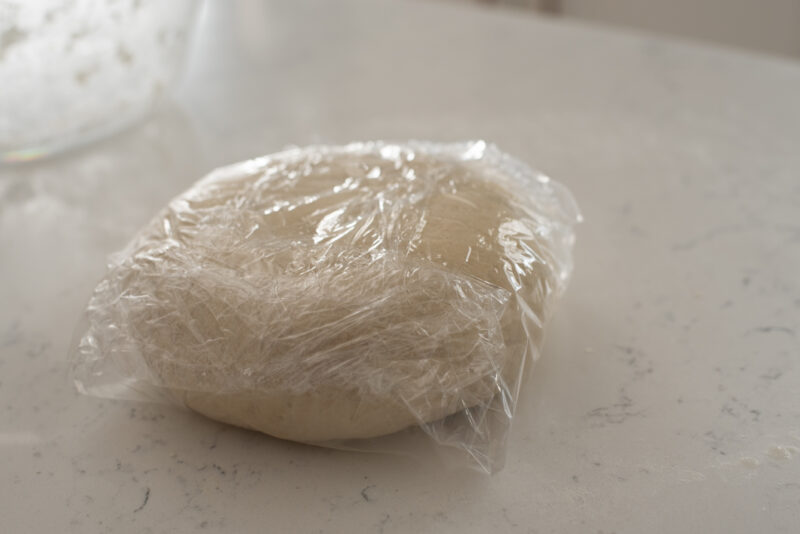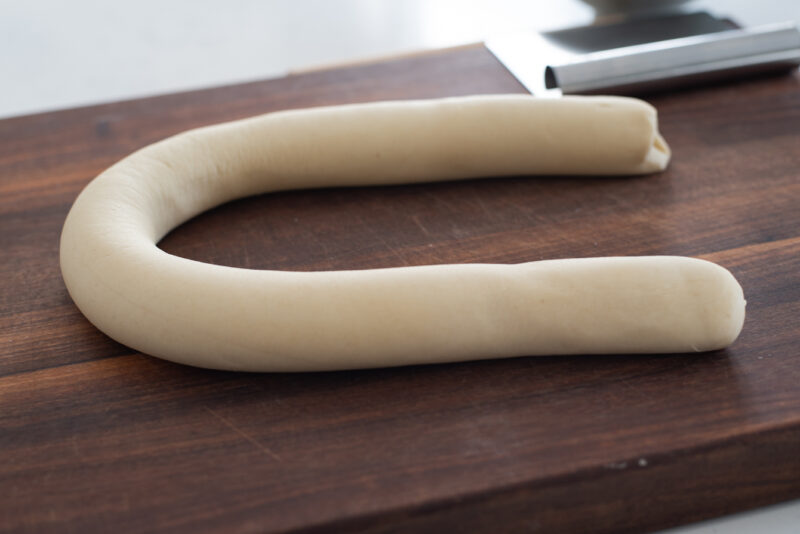Homemade Korean Dumpling Wrappers (Mandu-pi)
Try these homemade dumpling wrapper recipe for Korean Mandu. The texture is softer and chewier than regular dumpling wrappers.

Lunar New Year is coming soon and I want to make loads of Korean dumplings, mandu (만두), this year. These Korean-style homemade dumpling wrappers are a must to make the delicious Korean dumplings.
The Solar New Year is always on January 1st. However the calendar date of Lunar New Year changes every year. It usually lands some time in February, but it also can be in late January depending on the cycle of the moon each year. As a child, my parents always celebrated Lunar New Year rather than the calendar New Year.
Making Homemade Mandu (Korean dumplings) a day before the New Year is a traditional activity that many Koreans do with their families at home. In olden days, people made homemade dumpling wrappers from scratch. We call it mandu-pi (만두피). It literally means, “dumpling skin”.

Although the usual recipe for dumpling wrappers is simple (the ingredients are often just flour and water), making the dough into wrappers takes time and effort.
We are not talking about rolling up a couple dozen of wrappers, it can be over 100 pieces if you have a big family. People usually make more than they need and freeze the rest for a later use.
Because making dumpling wrappers can be time consuming work, many modern-day Korean cooks at home choose store-bought wrappers to save time. However, there are still many people who would go through the trouble of making homemade dumpling wrappers from scratch.
Why? Because they taste so much better and folding the dumplings is such beautiful, rewarding work.
Besides, making dumpling is a great family get-together activity. So, why not start with homemade dumpling wrappers to begin with?

Recipe FAQs
How Korean dumpling wrappers (Mandu-pi) are different than other dumpling wrappers?
Most dumpling wrapper recipes are made with plain flour and water. This Korean dumpling wrapper recipe includes sweet rice flour and cornstarch on top of flour.
The addition of sweet rice flour and cornstarch will help the dough to be tender, yielding a chewier texture. Above all, it rolls beautifully and I found this dough to be easier to work with when you are folding the dumplings.
Another difference would be the size. Korean dumplings tend to be bigger than other Asian dumplings. Therefore the dumpling wrappers should be made bigger, too. Most Asian dumpling wrappers are about 3 1/2 to 4 inch in diameter. Korean dumpling wrappers are between 4 1/2 to 5 inch in diameter.
Can you make dumpling wrappers ahead of time?
Of course. You can make them ahead of time and keep them in the fridge up to a week, or freeze them up to several months. Make sure to sprinkle enough flour in between the wrappers so that they don’t stick to each other. Wrap them in plastic and put them in an airtight zip-top bag.
How To Make Korean Dumpling Wrappers (mandu-pi)

To make the dumpling dough, mix flour, sweet rice flour, and cornstarch in a large mixing bowl.

Add oil and water; mix with a spoon. Do not add all the water at once. Gradually add water until it forms into a thick dough. You can add more water if needed.

Knead the dough with your hand for 2-3 minutes until smooth. Wrap in plastic and let the dough rest for 30 minutes at room temperature, or a few hours in the fridge. Bring to a room temperature before you roll out.

Roll the dough into a long log with about 1 1/2-inch in diameter.

To make large wrappers (5-inch), cut into 40-45 pieces. Each piece should weigh about 30g (1 oz). To make smaller wrappers (about 4-inch), cut into 55-60 pieces. Each piece should weigh about 20g (0.7 oz).
If you want to make Korean style dumplings, I recommend to choose a large size.

Roll each dough piece into a round wrapper to the size you decided. I made mine to be about 5-inch in diameter. Dust with flour before you put the next wrapper on top to prevent sticking.
A short rolling pin (dumpling pin) comes in handy to roll out the dough in a round shape. Don’t worry if your wrappers are not as round as you wish. It doesn’t have to be perfect. You can always cut along as you make the dumplings.
Make sure to cover the rest of the dough pieces with a damp cloth as you are working, so that they don’t dry out while waiting.

I will post a very delicious Korean pork dumpling recipe in my next posting.
I think it is quite a therapeutic thing to make homemade dumplings. It’s fun to fold them into different shapes. If you have children at home, it becomes even funnier because kids always shape them into their own unique style.
Want to make homemade mandu with this dumpling wrapper recipe? Try adding your finished dumplings to your Korean army stew (budae jjigae), bulgogi hotpot or quick Korean dumpling soup (Mandu-guk).

Stay in touch with me on Facebook, Pinterest, and Instagram for all the latest updates. And don’t forget to leave a comment and star rating if you like this post. That means a lot to me. Thank you!

Korean Homemade Dumpling Wrappers (Mandu-pi)
Ingredients
- 4 cups (480 g) all-purpose flour, or plain flour
- 3 tbsp (24 g) sweet rice flour (chapssal-garu)
- 2 tbsp (16 g) constarch
- 2 tbsp (30 ml) vegetable oil
- 1 1/2 cup (360 ml) warm water, + 2 tbsp more, if needed
Equipment
Instructions
- To make the dumpling dough, mix flour, sweet rice flour, and cornstarch in a large mixing bowl.
- Add oil and water; mix with a spoon. Do not add all the water at once. Gradually add water until it forms a rather thick dough. You can add more water if needed.
- Knead the dough with your hand for 2-3 minutes until smooth. Wrap in plastic and let the dough rest for 30 minutes in the room temperature or a few hours in the fridge. Bring to a room temperature before you roll out.
- Roll the dough into a long log with about 1 1/2-inch in diameter.
- To make large wrappers (5-inch), cut into 40-45 pieces. Each piece should weigh about 30g (1oz). To make smaller wrappers (about 4-inch), cut into 55-60 pieces. Each piece should weigh about 20g (0.7oz).
- Roll each dough pieces into a round wrapper with a small rolling pin, about 5-inch in diameter. Dust with flour before you put the next wrapper on top to prevent from sticking.


Would a pasta roller work to roll out the dough, then use a round biscuit cutter?
It should work, but you might end up with a smaller quantity of wrappers.
I tried your recipe and the result was amazing ! Soft , tender , easy to shape wrapper has made cooking Mandu full of joy 😍
Ofcourse it’s tasty
Thank you dear Holly 🙏🏻🌹
So happy to hear that. Thank you so much!
Hi, Can I substitute cornstarch with tapioca flour?
Yes, tapioca flour should work, too. Thanks.
What thickness should the dumpling wrapper be?
Hi Darlene
The thickness should be around 1/8-inch. You can make it slightly thicker or thinner depending on your preference. Hope you like it. Thanks.
is sweet rice flour necessary? could I just substitute it for regular flour and still add the corn starch?
Of course, you can still make a dumpling dough without the sweet rice flour. The texture won’t be exactly the same, but still makes good dumpling wrappers.
the recipe says to add more water if needed. Is it needed if the dough is too dry? I used the recommended amount of water and my dough is s very sticky…I guess I will need to add flour before I can do anything with it. Since I am in the middle of it, I’ll muddle through the best I can! Yaki mandu was one of my favorite foods when I was stationed in Korea. First time I’ve attempted making it from scratch! Thanks for the recipe.
Hi Kate
Thank for your comment. I’m sorry to hear that the dough was too sticky. I think it is important to add water gradually to the flour mixture and stop when you reach the right consistency. When I attempted, the amount of water given in the recipe was just perfect for me.
However, if the dough seems very sticky, you can add more flour and it’s perfectly okay. I hope you were able to roll out the dough fine. Let me know if your have more questions.
I love yaki mandu as well – homemade wrappers make it even tastier, right?
Thanks, Holly. I’ll admit I read the instructions to gradually add the water AFTER I had dumped it in! Adding flour till it seemed right worked great. The dough came out perfectly. Super easy to roll too. Thanks again.
Is the sweet rice flour the same as mochi flour?
Yes, Korean sweet rice flour is similar to mochi flour and you can use them both in this recipe.
I like to make my own wrappers too. So much fresher and better!
I haven’t make dumpling wrappers in a very long time, and never this particular style. Terrific recipe — so clear and straightforward. Thanks!
Thanks, John. Hope you get to try this recipe when you are in the mood for making homemade dumplings/
Thank you so much for sharing this! I was searching for a soft, light, tender dumpling skin recipe. Your recipes are always fail-proof and high quality.
Thank you so much for your compliment. Hope these dumpling wrappers are what you’re looking for. Happy Lunar New Year!